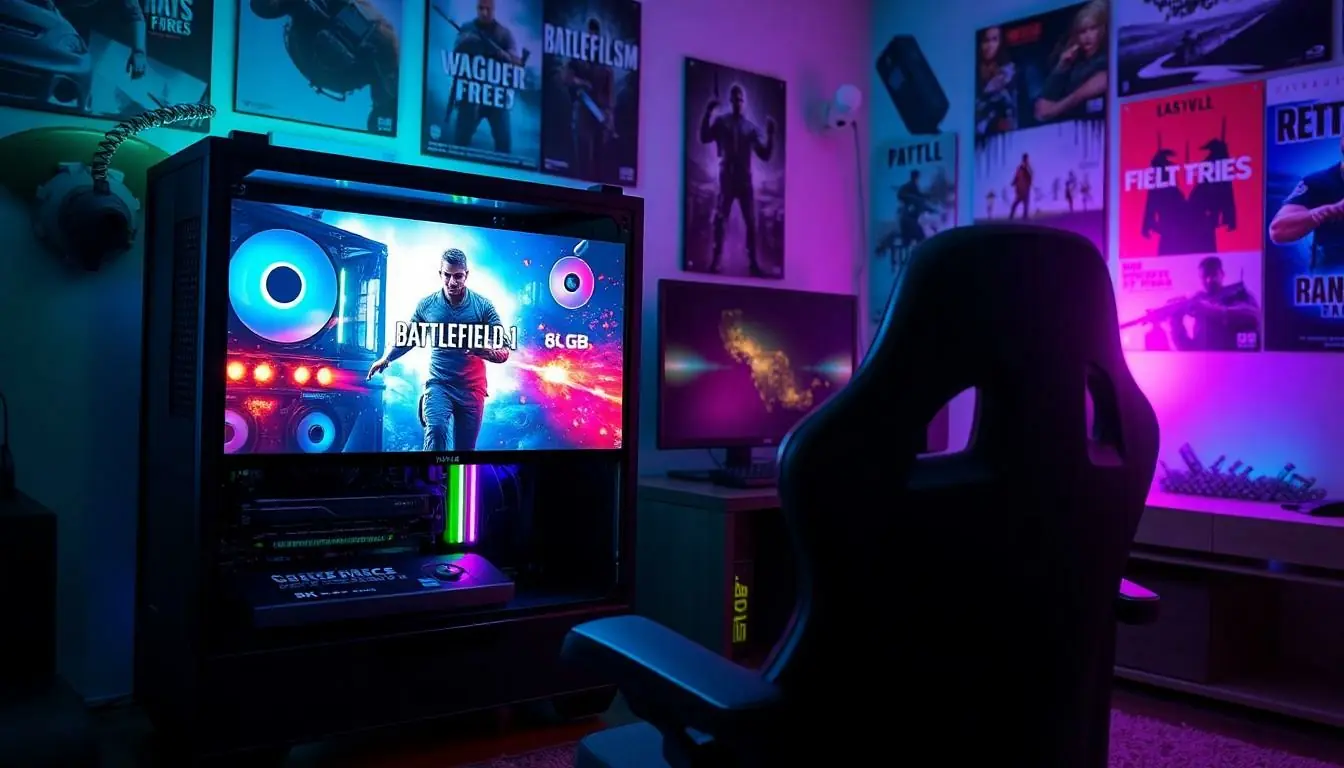Table of Contents
ToggleIn the chaotic world of Battlefield 1, players dive headfirst into epic battles that redefine the First World War experience. But before anyone can charge into the fray, they need to ensure their PC can handle the explosive action. Nobody wants to be the soldier stuck in the trenches of lag, right?
Battlefield 1 PC Requirements Overview
Players seeking to enjoy Battlefield 1 must ensure their PCs meet specific system requirements. The minimum requirements include an Intel Core i5 6600K or AMD FX-6350 processor. For RAM, 8 GB is essential to run the game smoothly. A graphics card, such as NVIDIA GeForce GTX 660 or AMD Radeon HD 7850, is necessary to handle the visual demands.
Optimizing performance requires meeting the recommended specifications. An Intel Core i7 4790 or AMD FX-8350 processor enhances gameplay quality. Having 16 GB of RAM allows for better multitasking and smoother gaming experiences. For graphics, the NVIDIA GeForce GTX 970 or AMD Radeon R9 290X supports higher settings and improved performance.
Storage also plays a crucial role. At least 50 GB of available space is needed to install Battlefield 1 and its updates. A solid-state drive (SSD) can significantly reduce loading times, providing a more seamless experience.
Connectivity demands should not be overlooked. A stable internet connection, with a minimum speed of 512 Kbps, is necessary for online gameplay. Players experiencing issues may benefit from faster connections for reduced lag.
Understanding these requirements ensures an enjoyable gaming experience in Battlefield 1. Meeting or exceeding them allows players to immerse themselves fully in the intense battles of the First World War.
Minimum System Requirements
Meeting the minimum system requirements is crucial for an optimal experience in Battlefield 1. Below are specific details regarding the necessary hardware components for gameplay.
Processor Specifications
An Intel Core i5 6600K processor or AMD FX-6350 processor is required to run Battlefield 1. Performance improves with 4 cores or more, ensuring smooth gameplay. Prioritizing CPU speed enhances responsiveness during intense battles. While these specifications suffice for minimum settings, players might encounter limitations in performance. Upgrading to a more powerful processor elevates the gaming experience significantly.
Memory Requirements
A minimum of 8 GB of RAM is essential for Battlefield 1’s gameplay. Having adequate memory prevents lag and stuttering during combat. Utilizing a RAM upgrade allows for better multitasking and improved load times. Ensuring memory speed complements the processor enhances overall performance. Players aiming for higher graphics settings should consider investing in 16 GB of RAM for an optimal experience.
Graphics Card Specifications
To meet the minimum requirements, a graphics card like the NVIDIA GeForce GTX 660 or AMD Radeon HD 7850 is necessary. These graphics cards support the game’s visual effects while maintaining a reasonable frame rate. Choosing a more recent model can significantly improve graphical fidelity. Compatibility with direct rendering ensures a seamless gaming experience. Investing in a GPU upgrade improves overall visual quality, making battles more immersive.
Storage Requirements
Storage capacity of at least 50 GB is required for Battlefield 1. Installing the game on a solid-state drive (SSD) minimizes loading times significantly. SSDs enhance general system performance and improve responsiveness. Using a traditional hard drive may result in longer load times, affecting gameplay flow. Opting for an SSD ensures quicker access to game files and a smoother gaming experience overall.
Recommended System Requirements
For an enhanced experience in Battlefield 1, meeting recommended system requirements ensures smooth gameplay and stunning graphics. The following specifications offer guidance for optimal performance.
Processor Specifications
An Intel Core i7 4790 or AMD FX-8350 processor facilitates seamless gameplay. Choosing a processor with at least four cores significantly improves performance during intense battles. Higher clock speeds contribute to better frame rates, especially in demanding scenes. This level of processing power minimizes lag, allowing players to focus on strategy and combat rather than technical issues. Upgrading to these specifications guarantees a noticeable difference in gaming quality.
Memory Requirements
Sixteen gigabytes of RAM is recommended for Battlefield 1 to enhance multitasking capabilities. This amount supports gaming alongside applications like voice chat or streaming software. While eight gigabytes meets minimum standards, higher RAM capacity prevents potential slowdowns. Improved memory availability contributes to better load times and overall system responsiveness. These specifications provide a fluid gaming experience and prevent interruptions during critical moments.
Graphics Card Specifications
An NVIDIA GeForce GTX 970 or AMD Radeon R9 290X graphics card produces stunning visuals and enables high-quality settings. These graphics cards offer advanced rendering capabilities necessary for detailed environments. Investing in a more powerful graphics card enhances anti-aliasing and texture quality. Achieving top-notch graphics ensures that players fully immerse themselves in the captivating world of World War I combat. Higher quality graphics cards truly elevate the experience.
Storage Requirements
To optimize loading times, a solid-state drive (SSD) is strongly recommended for Battlefield 1 installation. With at least 50 gigabytes of available storage, an SSD dramatically reduces wait times compared to traditional hard drives. Faster read and write speeds contribute to smoother transitions between game menus and missions. This improvement allows players to jump into action quickly, maintaining the excitement of the game. Prioritizing an SSD for installation significantly enhances the overall experience.
Performance Considerations
Understanding performance considerations is essential for an optimal Battlefield 1 experience. Players should adjust settings based on their hardware capabilities to fully enjoy the rich visuals and immersive gameplay.
Resolution and Graphics Settings
Resolution can significantly impact performance. A higher resolution enhances visual fidelity but demands more from the graphics card. Players might notice improved detail when using 1080p, while 1440p and 4K may challenge even the best systems. Graphics settings also play a critical role. Lowering options like shadows and textures can boost frame rates without sacrificing too much visual quality. Players with minimum requirements can experiment with medium settings to achieve smoother performance.
Frame Rate Expectations
Frame rate expectations vary based on hardware. Systems meeting minimum specifications often deliver around 30 frames per second, which might feel choppy during intense moments. Upgrading to recommended specifications typically results in a smoother experience, reaching 60 frames per second or more. Achieving higher frame rates allows for better responsiveness, notably in competitive situations. Players should monitor performance using in-game tools or external software for optimizing gameplay settings effectively.
Conclusion
Meeting the PC requirements for Battlefield 1 is essential for an enjoyable gaming experience. Players should prioritize a capable processor and sufficient RAM to ensure smooth gameplay during intense battles. Selecting a suitable graphics card can significantly enhance visual quality and overall immersion.
Installing the game on an SSD will minimize loading times and maintain the game’s fast-paced nature. By understanding their system’s capabilities and making necessary upgrades, gamers can fully engage in the thrilling world of Battlefield 1 without interruptions. Embracing these recommendations will lead to a more satisfying and seamless gaming experience.








